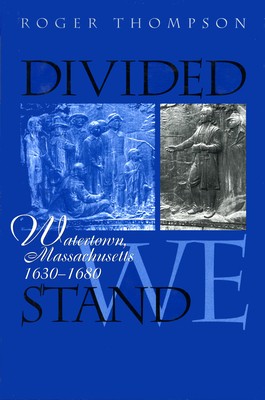
- We will send in 10–14 business days.
- Author: Roger Thompson
- Publisher: University of Massachusetts Press
- ISBN-10: 155849961X
- ISBN-13: 9781558499614
- Format: 15.6 x 23.4 x 1.6 cm, minkšti viršeliai
- Language: English
- SAVE -10% with code: EXTRA
Reviews
Description
Established in 1630, Watertown was among the original six towns of Massachusetts. Its early history was marked by frequent disputes, a penchant for questioning authority, and an atmosphere of tension and discord. In recounting the story of Watertown's formative years, Roger Thompson examines how the community managed to avoid descending into anarchy. He also explores the ways in which English settlers preserved their habits of behavior in a new-world environment, even as they were obliged to innovate and embrace change.
Thompson describes Watertown's early government, its relations with Native Americans and neighboring communities, its religious and economic affairs, and the day-to-day experiences of its people. Conflict occurred over a wide variety of issues: land allocation, administrative accountability, religious orthodoxy and exclusivity, generational and gender differences, livestock and fencing, haves and have-nots. Thompson brings these disputes to life through a series of vivid case studies drawn from the unpublished Middlesex County Court Records. Among others, we meet John Sawin, who despite his best efforts at subterfuge was convicted of stealing and selling a neighbor's horse; Susanna Woodward, whose pregnancy resulted in a fiercely contested paternity case; and Edward Sanders, whose punishment for child abuse was both a whipping and a ruling that when in public he must "wear a rope round his neck openly to be seen hanging down two feet." Throughout the book, the same themes reappear: continuity and change, the persistent conflicts of the first two generations, and the countervailing forces of communal cohesion.EXTRA 10 % discount with code: EXTRA
The promotion ends in 23d.07:35:56
The discount code is valid when purchasing from 10 €. Discounts do not stack.
- Author: Roger Thompson
- Publisher: University of Massachusetts Press
- ISBN-10: 155849961X
- ISBN-13: 9781558499614
- Format: 15.6 x 23.4 x 1.6 cm, minkšti viršeliai
- Language: English English
Established in 1630, Watertown was among the original six towns of Massachusetts. Its early history was marked by frequent disputes, a penchant for questioning authority, and an atmosphere of tension and discord. In recounting the story of Watertown's formative years, Roger Thompson examines how the community managed to avoid descending into anarchy. He also explores the ways in which English settlers preserved their habits of behavior in a new-world environment, even as they were obliged to innovate and embrace change.
Thompson describes Watertown's early government, its relations with Native Americans and neighboring communities, its religious and economic affairs, and the day-to-day experiences of its people. Conflict occurred over a wide variety of issues: land allocation, administrative accountability, religious orthodoxy and exclusivity, generational and gender differences, livestock and fencing, haves and have-nots. Thompson brings these disputes to life through a series of vivid case studies drawn from the unpublished Middlesex County Court Records. Among others, we meet John Sawin, who despite his best efforts at subterfuge was convicted of stealing and selling a neighbor's horse; Susanna Woodward, whose pregnancy resulted in a fiercely contested paternity case; and Edward Sanders, whose punishment for child abuse was both a whipping and a ruling that when in public he must "wear a rope round his neck openly to be seen hanging down two feet." Throughout the book, the same themes reappear: continuity and change, the persistent conflicts of the first two generations, and the countervailing forces of communal cohesion.

Reviews